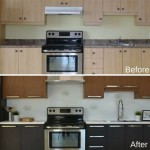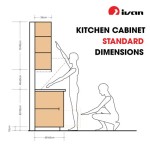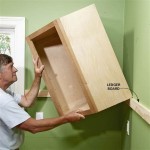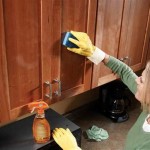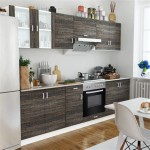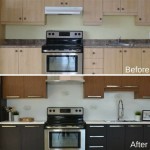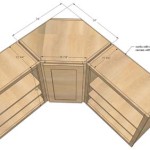How To Hang Kitchen Cabinets On Concrete Walls
Hanging kitchen cabinets on concrete walls presents a unique set of challenges compared to installing them on traditional stud walls. Concrete, being a dense and rigid material, requires specific anchoring methods and tools to ensure secure and long-lasting cabinet installation. This article details a comprehensive guide on how to successfully hang kitchen cabinets on concrete walls, covering everything from essential tools and materials to step-by-step instructions and safety precautions.
Planning and Preparation
Before commencing the physical installation, meticulous planning and preparation are crucial. This stage involves assessing the concrete wall, accurately measuring and marking cabinet locations, and gathering the necessary tools and materials. A thorough initial assessment minimizes errors and ensures a smoother installation process.
The first step is to inspect the concrete wall for any signs of damage, such as cracks or crumbling. Addressing these issues prior to cabinet installation is vital for the structural integrity of the installation. Minor cracks can often be filled with concrete patching compound, while more significant damage might necessitate professional repair. Furthermore, verify the flatness of the wall. Significant unevenness can lead to difficulties in aligning the cabinets properly. Shimming might be required to achieve a level surface.
Next, determine the desired layout of the kitchen cabinets. This involves deciding on the position of upper and lower cabinets, as well as any other wall-mounted fixtures. Use a level and measuring tape to accurately mark the locations of the cabinet mounting points on the concrete wall. Pay close attention to the height and spacing of the cabinets, ensuring they are aligned and level. A laser level can be particularly helpful for establishing a consistent horizontal line across the wall.
The selection of appropriate tools and materials is paramount for a successful installation. Essential tools include a hammer drill with concrete drill bits, a level (preferably a laser level), a measuring tape, a stud finder (although less relevant for concrete, it can help identify any existing wiring or plumbing within the wall), a pencil or marker, safety glasses, and work gloves. For anchoring the cabinets, concrete screws or expansion anchors are typically used. The specific type and size of fastener will depend on the weight of the cabinets and the density of the concrete. Consult with a hardware specialist to determine the appropriate fasteners for the specific application.
Selecting the Right Anchors and Fasteners
The choice of anchors and fasteners is crucial for ensuring the secure attachment of kitchen cabinets to concrete walls. Several options are available, each with its own advantages and limitations. Careful consideration must be given to factors such as the weight of the cabinets, the type of concrete, and the desired holding strength.
Concrete screws are a popular choice for attaching cabinets to concrete, offering ease of installation and reliable holding power. These screws are designed to tap directly into pre-drilled holes in the concrete, eliminating the need for separate anchors. However, they are best suited for lighter to medium-weight cabinets. Ensure that the concrete screws are specifically designed for concrete and are of sufficient length to penetrate the concrete deeply enough to provide adequate holding strength.
Expansion anchors provide a more robust anchoring solution, particularly for heavier cabinets or situations where greater holding strength is required. These anchors work by expanding within the pre-drilled hole as the screw is tightened, creating a mechanical interlock with the concrete. There are several types of expansion anchors available, including sleeve anchors, wedge anchors, and drop-in anchors. The choice of anchor will depend on the specific application and load requirements. Sleeve anchors are a versatile option, suitable for a wide range of applications. Wedge anchors are known for their high holding power, making them ideal for heavy-duty applications. Drop-in anchors require a specialized setting tool for installation but offer a flush finish.
Regardless of the type of anchor or fastener chosen, it is imperative to follow the manufacturer's instructions carefully. This includes drilling the correct size hole, inserting the anchor or screw properly, and tightening it to the specified torque. Over-tightening can damage the anchor or concrete, while under-tightening can compromise the holding strength.
Installation Procedure
The installation procedure involves a series of steps, starting with drilling pilot holes in the concrete wall and culminating in the secure attachment of the cabinets. Precision and attention to detail are essential throughout the process to ensure a level and stable installation.
Using a hammer drill and the appropriate size concrete drill bit, drill pilot holes in the concrete wall at the marked locations. The diameter of the drill bit should match the specifications of the chosen anchors or fasteners. Ensure that the holes are drilled to the correct depth, as specified by the manufacturer. When drilling, apply consistent pressure to the drill and avoid forcing it. If the drill bit becomes clogged, remove it and clean it before continuing.
Once the pilot holes are drilled, insert the chosen anchors or fasteners into the holes. If using expansion anchors, follow the manufacturer's instructions for setting the anchor. This may involve using a hammer to drive the anchor into the hole or using a specialized setting tool. For concrete screws, simply insert the screw into the hole and tighten it with a screwdriver or wrench. Ensure that the anchors or screws are seated flush with the surface of the concrete wall.
With the anchors in place, carefully lift the first cabinet into position and align it with the marked locations on the wall. Use shims, if necessary, to ensure that the cabinet is level and plumb. Secure the cabinet to the concrete wall by driving screws through the cabinet's mounting rails and into the anchors. Start with the top screws and work your way down, ensuring that the cabinet remains level and plumb throughout the process. Repeat this procedure for each remaining cabinet, ensuring that they are properly aligned and secured to the wall. Adjacent cabinets should be connected to each other using screws or bolts to create a unified and stable structure.
After all cabinets are installed, conduct a thorough inspection to ensure that they are level, plumb, and securely attached to the concrete wall. Check that all screws and bolts are tightened to the appropriate torque. Make any necessary adjustments to shims or fasteners to ensure that the cabinets are perfectly aligned and stable.
Safety Precautions
Working with power tools and concrete can pose certain safety risks. Adhering to safety precautions is essential to prevent injuries and ensure a safe working environment.
Always wear safety glasses and work gloves when drilling into concrete. Concrete dust can be harmful to the eyes and skin. A dust mask is also recommended to prevent inhalation of concrete dust. When using a hammer drill, be aware of the noise level and wear hearing protection if necessary.
Before drilling into the concrete wall, use a stud finder to identify the location of any electrical wiring or plumbing. Drilling into these components can cause serious damage and pose a safety hazard. If unsure about the location of wiring or plumbing, consult with a qualified electrician or plumber.
Ensure that the work area is well-lit and free of obstructions. Use caution when lifting heavy cabinets to prevent back injuries. If necessary, enlist the help of another person to lift and position the cabinets. When using power tools, follow the manufacturer's instructions carefully and avoid using damaged or malfunctioning tools.
Dispose of concrete dust and debris properly. Concrete dust can be irritating to the skin and lungs. Avoid sweeping or vacuuming concrete dust, as this can create airborne particles. Instead, use a wet mop or vacuum with a HEPA filter to clean up concrete dust.

Cabinets Around The House How To Attach A Kitchen Cabinet Concrete Walls

Installing Kitchen Cabinets Diy House Renovations

How To Install Kitchen Cabinets On Concrete Brick Walls Drywall

How To Attach A Kitchen Cabinet Concrete Walls

How To Mount Cabinets On Concrete Wall Hang Install Or Cinder Block

Figuring This Out Doubled My Storage

Hanging Cabinets On Concrete Wall Tiktok Search

Install Wall Cabinets Without Studs Theplywood Com

How To Install Hang Wall Cabinets Easy Simple

How To Hang Cabinets On A Brick Wall Fine Homebuilding
Related Posts


